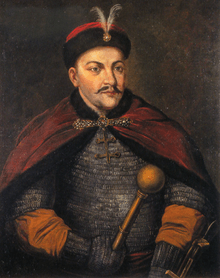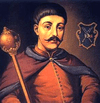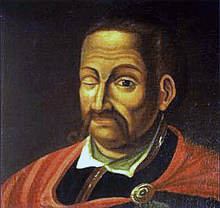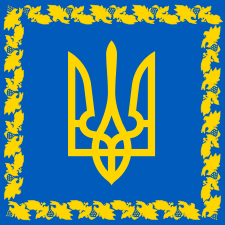Hetman of Zaporizhian Host
| Hetman of Zaporizhian Host | |
|---|---|
|
State flag | |
 | |
| Residence |
Chyhyryn (originally) Hetman Residence, Baturyn |
| Appointer | General Military Council |
| Formation | 26 January 1648 |
| First holder | Bohdan Khmelnytsky |
| Final holder | Kyrylo Rozumovsky |
| Abolished | 17 November 1764 |
Hetman of Zaporizhian Host (Ukrainian: Гетьман Війська Запорозького, Russian: Гетман Войска Запорожского, Polish: Hetman wojsk kozackich) is a former historic government office and political institution of Cossack Hetmanate (Zaporizhian Host) in Ukraine that was equivalent to a head of state. The office was liquidated on the edict of Russian Governing Senate of 17 November 1764.[1]
Brief history
As a head of state the position was established at first by Bohdan Khmelnytsky during the Cossack Hetmanate in the mid 17th century. During that period the office was electoral. All elections except for the first one were adapted by the Senior Council in Chyhyryn which until 1669 served the capital of Hetmanate.
Since the council in Pereyaslav of 1654 several senior cossacks sided with the Tsardom of Russia and in 1663 they staged "Black Council" (Chorna Rada) in Nizhyn which elected Ivan Briukhovetsky as an alternative hetman. Since the defeat of Petro Doroshenko in 1669 the Hetman title was adapted by pro-Russian elected hetmans who resided in Baturyn. In the course of the Great Northern War one of them, Ivan Mazepa, decided to revolt against Russian rule in 1708 which later drew terrible consequences for the Cossack Hetmanate as well as the Zaporizhian Host. The administration was moved to Hlukhiv where the Mazepa's doll was publicly executed and anathema was laid against him by the Russian Orthodox Church. Later in the late 18th century it was successfully disbanded by the Russian government during the expansion of the Russian territory towards the Black Sea coast.
In 1764 the Russian Empress Catherine the Great issued a secret instruction to Prince Vyazemsky who was Procurator General of the Governing Senate.[2][3]
“Little Russia, Livonia, Finland are provinces which are governed based on granted to them privileges; trespass them by suddenly canceling would be very unethical, yet to call them alien and treat them as such would be more than mistake; perhaps even a nonsense. Those provinces as well as Smolensk must be in the easiest way steered to be Russified and ceased to "look as if wolves to woods". To accomplish that will be very easy if wise men will be elected governors of those provinces. When the Little Russia would not have its hetman, it is necessary that the period and the name of hetmans disappeared.”
~ Catherine the Great, 1764
List of office holders
| # | Hetman | Elected (event) | Took office | Left office | ||
|---|---|---|---|---|---|---|
| 1 |  |
Bohdan Khmelnytsky (1596–1657) Зиновій-Богдан Хмельницький |
1648 (Sich) | 26 January 1648 | 6 August 1657 | died |
| 2 |  |
Yurii Khmelnytsky (1641–1685) Юрій Хмельницький |
death of his father | 6 August 1657 | 27 August 1657 | reconsidered by the Council of Officers |
| 3 | |
Ivan Vyhovsky (????–1664) Іван Виговський |
1657 (Korsun) | 27 August 1657 (confirmed: 21 October 1657) |
11 September 1659 | surrendered title |
| 4 |  |
Yurii Khmelnytsky (1641–1685) Юрій Хмельницький |
1659 (Hermanivka) | 11 September 1659 (confirmed: 11 September 1659) |
October 1662 | surrendered title |
| x | Pavlo Teteria (1620?–1670) Павло "Тетеря" Моржковський |
1662 (Chyhyryn) | October 1662 | July 1665 | (legitimacy questioned) | |
| 5 |  |
Ivan Briukhovetsky (1623–1668) Іван Брюховецький |
1663 (Nizhyn) | 27 June 1663 (confirmed: 27 June 1663) |
17 June 1668 | died |
| 6 |  |
Petro Doroshenko (1627–1698) Петро Дорошенко |
1666 (Chyhyryn) | 10 October 1665 (confirmed: January 1666) |
19 September 1676 | surrendered to Ivan Samoylovych |
| x |  |
Demian Mnohohrishny (1631–1703) Дем'ян Многогрішний |
1669 (Hlukhiv) | 17 December 1668 (confirmed: 3 March 1669) |
April 1672 | arrested and exiled to Siberia |
| 7 |  |
Ivan Samoylovych (1630s–1690) Іван Самойлович |
1672 (Cossack Grove) | 17 June 1672 | August 1687 | arrested and exiled to Siberia |
| 8 |  |
Ivan Mazepa (1627–1698) Іван Мазепа |
1687 (Kolomak) | 4 August 1687 | 6 November 1708 | "stripped" of a title, discredited |
| 9 |  |
Ivan Skoropadsky (1646–1722) Іван Скоропадський |
1708 (Hlukhiv) | 6 November 1708 | 14 July 1722 | died |
| X | |
Pavlo Polubotok (1660–1724) Павло Полуботок |
appointed hetman | 1722 | 1724 | died in prison |
| Collegium of Little Russia (Stepan Velyaminov) 1722-1727 | ||||||
| 10 |  |
Danylo Apostol (1654–1734) Данило Апостол |
1727 (Hlukhiv) | 12 October 1727 | 29 March 1734 | died |
| X | Yakiv Lyzohub (1675–1749) Яків Лизогуб |
appointed hetman | 1733 | 1749 | died | |
| Governing Council of the Hetman Office (Aleksei Shakhovskoy) 1734-1745 | ||||||
| 11 |  |
Kyrylo Rozumovsky (1728–1803) Кирило Розумовський |
1750 (Hlukhiv) | 22 February 1750 | 17 November 1764 | resigned |
| Collegium of Little Russia 1764-1786 (Pyotr Rumyantsev) | ||||||
Some historians among which is Mykola Arkas[4] question legitimacy of the Teteria's elections accusing the later in corruption.[5] Also some sources claim election of Teteria having taken place in January 1663.[6] The election of Teteria led to the Povoloch Regiment Uprising in 1663, followed by bigger number of unrest in the modern region of Kirovohrad Oblast as well as Polesie (all in the Right-bank Ukraine).[7] Moreover, the political crisis that followed the Pushkar–Barabash Uprising divided the Cossack Hetmanate completely on both bank of Dnieper River.[7] Coincidentally, on 10 January 1663 the Tsardom of Muscovy created the new Little Russian Office (Prikaz) within its Ambassadorial Office.
Vouched by Charles Marie François Olier, marquis de Nointel, Yuriy Khmelnytsky was freed from the Ottoman captivity, appointed and along with Pasha Ibragim was sent to Ukraine fight the Moscow forces of Samoilovych and Romadanovsky. In 1681 Mehmed IV appointed George Ducas the Hetman of Ukraine, replacing Khmelnytsky.
Following the anathema on Mazepa and the election of Ivan Skoropadsky, Cossack Hetmanate was included into the Russian Government of Kiev in December 1708. Upon the death of Skoropadsky, the Hetman elections were disrupted and were awarded as a gift and a type of princely titles, first to Moldavian nobleman and later to the Russian Empress favorite.
On 5 April 1710 the council of cossacks, veterans of the battle at Poltava, elected Pylyp Orlyk as the Hetman of Ukraine in exile. Orlyk waged a guerrilla warfare at the southern borders of the Russian Empire with the support from Ottoman and Swedish empires.
See also
- List of leaders of Ukraine
- Hetmans of Zaporizhian Cossacks
- Hetmans of Ukrainians Cossacks
- Hetman of Ukraine
References
- ↑ Kyrylo Rozumovsky at the Jurist Encyclopedia
- ↑ Podobyed, O. Instructions of Catherine the Great to Senate. Handbook "History of Ukraine. 7-8 grades". Ranok Publishing House. ISBN 9789666724437
- ↑ Soroka, Yu. Hetmanless period and the last Hetman of Ukraine.
- ↑ Pavlo Teteria, Hetman of the Right-bank Ukraine. Cossack leaders of Ukraine (textbook).
- ↑ Lohvyn, Yu. Pavlo Teteria. Hetmans of Ukraine. "Merry Alphabet".
- ↑ Pavlo Teteria. History of the Great Nation.
- 1 2 Horobets, V. Civil wars in Ukraine of 1650s-1660s. Encyclopedia of history of Ukraine. Vol.2. Kiev: "Naukova Dumka", 2004.
Further reading
- Dyadychenko, V. Sketches of a social and political system of the Left-bank Ukraine at the end of 17th and the start of 18th centuries. Kiev 1959
- Smoliy, V. Hetmanate Ukraine. Kiev 1999
External links
- Shcherbak, V. Institution of Hetmans. Encyclopedia of History of Ukraine. "Naukova dumka". Kiev 2004
- Hetman. Encyclopedia of Ukraine.

